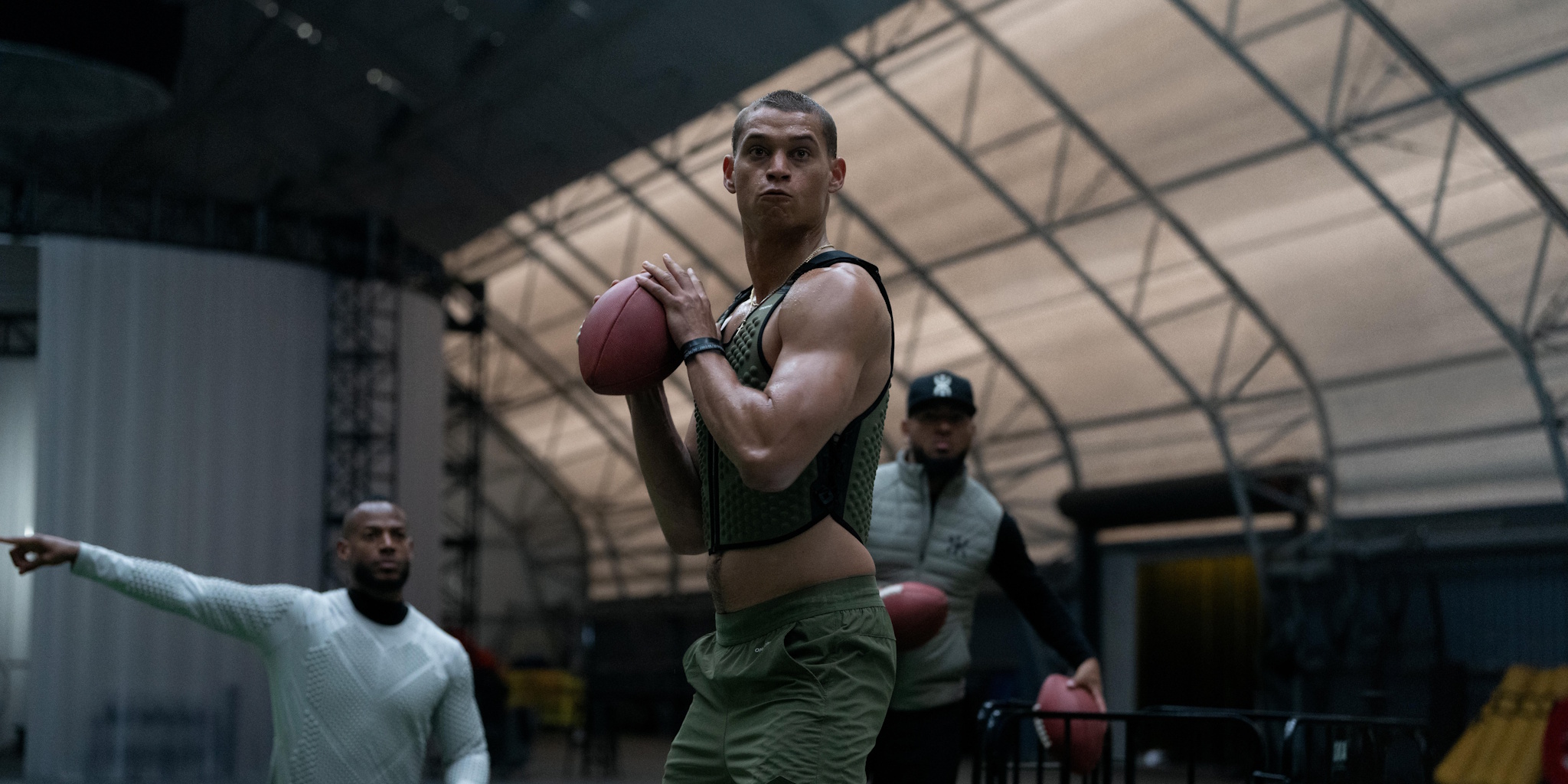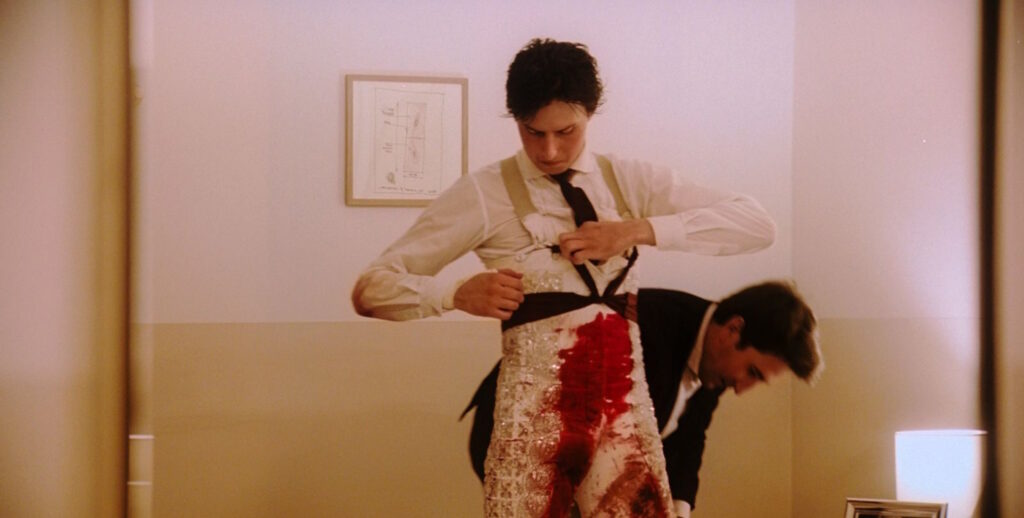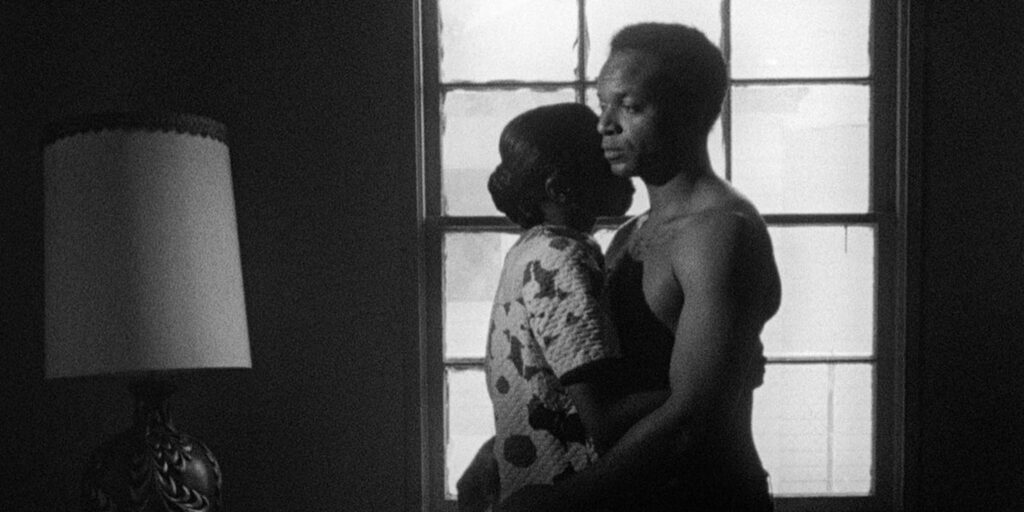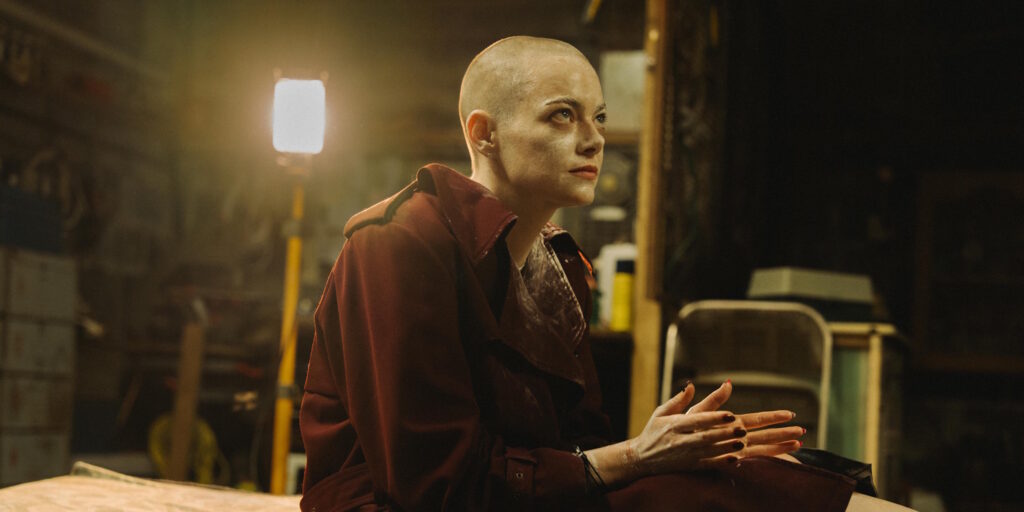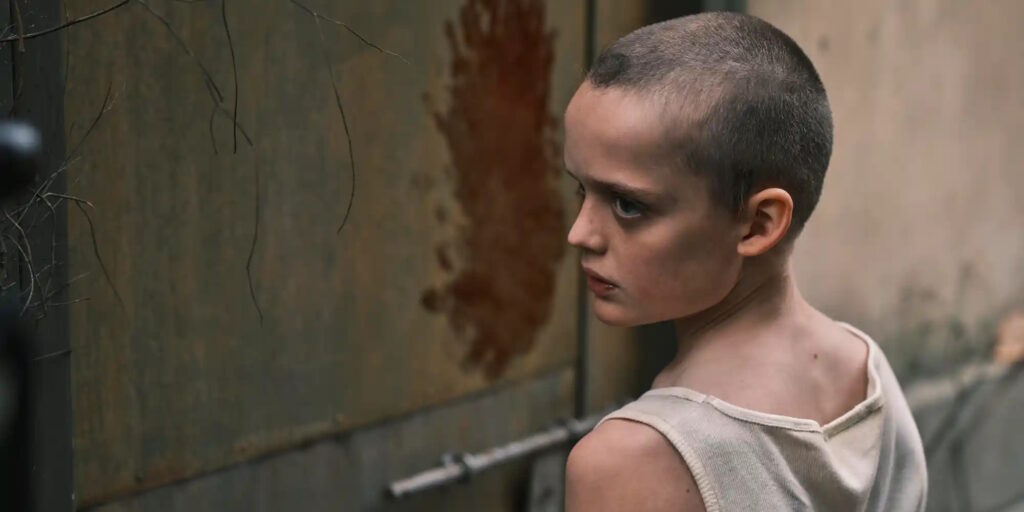Cameron Cade (Austin Pulliam) was raised to revere the American Holy Trinity: God, family, and football. In young Cam’s personal theology, the only figure that loomed larger than his high-expectations, masculinity-obsessed father (Don Benjamin) was legendary San Antonio quarterback Isaiah White (Marlon Wayans). Cam watched in awestruck revulsion as his idol suffered a gruesome leg injury on live television, while Dad reproached him for daring to look away from “a real man’s sacrifice.” Remarkably, White recovered from this setback and went on to play for another 14 years, racking up eight championship rings as Cam himself grew up and filled out (turning into Atlanta breakout Tyriq Withers).
Now Cam is the nation’s most coveted quarterback prospect heading into the pro draft, where he’s hoping to be picked up by his beloved San Antonio Saviors. Not incidentally, White is rumored to be on the verge of retirement, which means Cam is positioned to potentially be his hero’s literal successor. However, this childhood wish fulfillment comes crashing down one night when a crazed, unidentified fan attacks Cam during a late-night practice, cracking his skull with, of all things, an ornate medieval war hammer. This horrific injury not only sidelines Cam from the pre-draft scouting combine – an invitation-only workout week spectated by coaches, scouts, and other league bigwigs – but also jeopardizes his future pro career.
Enter a surprise proposal from White, negotiated by Cam’s transparently slimy agent (Tim Heidecker). White offers Cam training and rehab during a week-long retreat at the veteran player’s sprawling New Mexico compound – a kind of pre-draft, one-on-one quarterback boot camp. Cam takes this as a tacit, under-the-table recognition that he is being groomed as White’s replacement on the Saviors’ starting lineup, injury (and, apparently, draft order) notwithstanding. He’s also ecstatic that his idol’s gaze has settled on him, and his unconcealed glee as he accepts the call – hiding in the bathroom as if the conversation were private and a little bit shameful – suggests an overgrown kid whose lifelong crush has finally, impossibly asked him out.
However, the weirdness that has been lurking at the periphery of Cam’s imminent ascent swells into a keening discord once he arrives at White’s brutalist desert estate. White’s mercurial brand of celebrity charisma is unnerving, as he switches erratically between backslapping bonhomie, dictatorial bullying, and cryptic philosophizing. And that’s just the host: The compound is a snarl of off-putting spaces, rituals, and personalities, one that not-so-subtly signals that Cam has been selected for something darker (and much stranger) than good old-fashioned American bloodsport.
Fittingly, director Justin Tipping’s Him is a strange film, in ways that go well beyond the surface-level observation that “American football horror movie” is a pretty bizarre pitch. Tipping (The Chi, Kicks) reportedly reworked the film’s original script by Skip Bronkie and Zack Akers after it was snapped up by Jordan Peele’s Monkeypaw Productions. The screenplay’s buzzy history – it was a 2022 Black List favorite – is unusual, given that the writing might be the least successful part of Him. A trippy, giallo-inflected freakout that unabashedly portrays professional sport as a heathen ceremony of blood, greed, and power, the film is chiefly a showcase for Tipping’s off-the-leash stylistic excess. Does it make a lick of sense, either narratively or thematically? Not really. Is it weird, unsettling, and nightmarishly gorgeous? Definitely.
Like many “unauthorized” films that feature American pro football, Him is obliged to omit any trademarks connected to the real-world NFL (see also: North Dallas Forty, The Last Boy Scout, Any Given Sunday). This bestows the depicted league and teams with something of a store-band generic vibe – “We have the Kansas City Chiefs at home!” – but Tipping and his collaborators lean into the unreality of the films’ fictional world. Cinematographer Kira Kelly (Rez Ball), production designer Jordan Ferrer (Made for Love), set decorator Kellie Jo Tinney (Beef), and costume designer Dominique Dawson (Swarm) are all doing A-tier work here, stretching the film’s reported $27 million budget to create an immersive and surreal variation on American sports and celebrity culture.
White’s luxurious, minimalist estate – full of oddly proportioned concrete corridors and grotesque artworks straight out of a House Atreides photo spread – makes for a fantastic setting. Combined with the sere desert surroundings and the psycho-stalker fans camped on the edge of the property, it provides the film with a touch of sci-fi dystopia. White’s oddball personal style and habits confound Cam, but, of course, the rich and famous are permitted to have their eccentricities. White’s increasingly bizarre training regimen is easily hand-waved away as a non-traditional “system” for elite athletic success, especially when one is a hungry youngblood eager to glean a veteran player’s secret formula for victory. There’s a queer-flavored undercurrent of alternating seduction, manipulation, and abuse in the two characters’ interactions, amplified by the broad homoeroticism of football and the specifics of the setting. (Sauna, anyone?) Is it just a coincidence that Him is also the title of a notorious lost gay pornographic film about Jesus? Maybe.
White surrounds himself with an entourage of attendants and hangers-on, including a gaggle of masochistic third-string players and a washed-up personal doctor (Jim Jeffries) who hands out the obligatory performance-enhancing drugs. Popping in and out of the story is White’s influencer spouse, Elsie (Julia Fox, bleached platinum blond, eyebrows and all), who lazes indolently on the line between vapid trophy wife and insidious Lady Macbeth. Despite the veteran quarterback’s lip-service about discipline and self-denial, every day at the compound is a chaotic whirlwind of seemingly arbitrary trials and therapies, alternating with confessional (and occasionally interrogatory) heart-to-heart sessions with White. It’s as though the goal is not to train Cam for gridiron glory but to charm, disorient, and ultimately break him psychologically for some other, unfathomable purpose. (Spoiler: That’s exactly what it is.)
Him is not a subtle film: It brazenly slathers Christian, pagan, and occult iconography onto the glossy milieus of professional athletics and celebrity-lifestyle culture. The commonalities between humanity’s so-called barbaric past and allegedly enlightened modernity are explicitly referenced in the script, particularly where it concerns equivalencies between ancient gladiators and contemporary athletes. White speechifies about blood sacrifices, anointed ones, and lines of royal succession, but these historical connections feel less clunky and didactic when the film makes them via the details of its impressive production design. (I would bet a month’s salary that costume designer Dawson is a fan of Charles Fréger’s remarkable photographs of folk-festival costumes, given their striking resemblance to the film’s mascot and fan regalia.)
The film touches on hot-button topics surrounding the NFL, such as chronic traumatic encephalopathy (CTE), the grooming of economically vulnerable prospects, and the disconcerting racial angle to owner-player power dynamics. Yet these matters are treated less as thematically substantive criticisms of the sport than as cultural touchstones to invoke for textural purposes. Or, alternatively, as excuses for galvanic visual flourishes, such as the neon-hued “X-ray vision” shots that highlight the characters’ straining muscles, cracking bones, and tearing tendons. It’s admittedly riveting to see such flamboyant, Gaspar Noé-esque touches in a mainstream studio horror film, but the cultural and political weight of the subtext is overpowered by Tipping’s heady style. Viewers looking for a truly focused and incisive critique of American football will have to look elsewhere.
Him is not a horror film that’s particularly interested in offering cogent social commentary, or even an intelligible explanation about what the hell is going on. What exactly does White – and, by extension, all the nefarious players in the business of American football – want from Cam? Clearly something sinister, perhaps even supernatural, but rather than articulating its plot clearly, Him prefers to gesticulate via copious occult and religious symbolism. Not for nothing is the acronym for the “Greatest of All Time” also the name of a sacrificial animal. However, even in the film’s enthusiastically bloody climax, as the exasperated evil masterminds (literally) spill their guts about their secret plans, there’s still a distinct lack of lucidity. (Some of this is arguably attributable to editor Taylor Joy Mason’s odd choices, which leave the film’s final sequence in particular feeling a bit disjointed.)
Do horror films need to make sense, or are style, spectacle, and creepy vibes enough to keep a feature afloat? The critical longevity of perplexing Euro-horror masterworks like Blood and Black Lace (1964), A Lizard in a Woman’s Skin (1971), and Suspiria (1977) certainly suggest the latter. However, contemporary American horror audiences are a notoriously nitpicky lot, prone to rejecting any feature that doesn’t explain every jot of itself in a way that satisfies some idiosyncratic personal storytelling ruleset. Him seems designed to annoy such viewers. Fair enough: It’s a peculiar, messy film that roars its Grand Guignol ambitions to the heavens with the subtlety of a Blue Angels flyover, all without saying anything especially trenchant about its subject. Sometimes, however, it’s enjoyable to luxuriate in horror cinema that isn’t afraid to privilege the unsettling poetry of the gesture itself over the expression of deeper meaning. Or, to put it more bluntly, sometimes it’s fun when horror movies just get fucking weird.
Him opens in theaters everywhere on Friday, Sep. 19.
